
Alaska-Yukon-Pacific Exposition
Encyclopedia
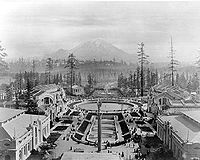
Pacific Northwest
The Pacific Northwest is a region in northwestern North America, bounded by the Pacific Ocean to the west and, loosely, by the Rocky Mountains on the east. Definitions of the region vary and there is no commonly agreed upon boundary, even among Pacific Northwesterners. A common concept of the...
.
It was originally planned for 1907, to mark the 10th anniversary of the Klondike Gold Rush
Klondike Gold Rush
The Klondike Gold Rush, also called the Yukon Gold Rush, the Alaska Gold Rush and the Last Great Gold Rush, was an attempt by an estimated 100,000 people to travel to the Klondike region the Yukon in north-western Canada between 1897 and 1899 in the hope of successfully prospecting for gold...
, but the organizers found out about the Jamestown Exposition
Jamestown Exposition
The Jamestown Exposition was one of the many world's fairs and expositions that were popular in the United States in the early part of the 20th century...
being held that year, and rescheduled.
The fairgrounds became the campus of the University of Washington
University of Washington
University of Washington is a public research university, founded in 1861 in Seattle, Washington, United States. The UW is the largest university in the Northwest and the oldest public university on the West Coast. The university has three campuses, with its largest campus in the University...
.
Planning
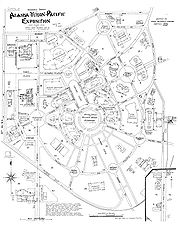
Alaska Territory
The Territory of Alaska was an organized incorporated territory of the United States that existed from August 24, 1912, until January 3, 1959, when it was admitted to the Union as the State of Alaska...
exhibit at the 1905 Lewis and Clark Exposition in Portland
Portland, Oregon
Portland is a city located in the Pacific Northwest, near the confluence of the Willamette and Columbia rivers in the U.S. state of Oregon. As of the 2010 Census, it had a population of 583,776, making it the 29th most populous city in the United States...
, Oregon
Oregon
Oregon is a state in the Pacific Northwest region of the United States. It is located on the Pacific coast, with Washington to the north, California to the south, Nevada on the southeast and Idaho to the east. The Columbia and Snake rivers delineate much of Oregon's northern and eastern...
. Originally, he pitched William Sheffield of the Alaska Club and James A. Wood, city editor of the Seattle Times on the idea of a permanent exhibit in Seattle about Alaska. This merged with Wood's desire for an exposition to rival Portland's. They soon gained the backing of Times publisher Alden J. Blethen
Alden J. Blethen
Alden J. Blethen was editor in chief of the Seattle Daily Times from August 10, 1896 until his death...
—remarkably, for the time, without gaining the opposition of the rival Seattle Post-Intelligencer
Seattle Post-Intelligencer
The Seattle Post-Intelligencer is an online newspaper and former print newspaper covering Seattle, Washington, United States, and the surrounding metropolitan area...
.
Edmond S. Meany
Edmond S. Meany
Edmond S. Meany was a professor of botany and history at the University of Washington and a UW alumnus, having graduated as the valedictorian of his class in 1885...
proposed that the exposition be held on the then largely forested campus of the University of Washington
University of Washington
University of Washington is a public research university, founded in 1861 in Seattle, Washington, United States. The UW is the largest university in the Northwest and the oldest public university on the West Coast. The university has three campuses, with its largest campus in the University...
, which in 1905 had exactly three buildings and little deliberate landscaping. At the time, this was considered rather far from the center of town, but Meany eventually sold the others involved on the idea that the forested campus could, itself, be an attraction for out-of-town visitors and that the trolley
Tram
A tram is a passenger rail vehicle which runs on tracks along public urban streets and also sometimes on separate rights of way. It may also run between cities and/or towns , and/or partially grade separated even in the cities...
ride from downtown would not be an obstacle to attendance. Of course, he was also highly aware of what the landscaping and structures could do for the campus.
The state legislature
Washington State Legislature
The Washington State Legislature is the state legislature of the U.S. state of Washington. It is a bipartisan, bicameral body, composed of the lower Washington House of Representatives, composed of 98 Representatives, and the upper Washington State Senate, with 49 Senators.The State Legislature...
endorsed the fair, with the proviso that it would produce at least four permanent buildings, and that any state monetary contribution would be focused mainly on those buildings. King County
King County, Washington
King County is a county located in the U.S. state of Washington. The population in the 2010 census was 1,931,249. King is the most populous county in Washington, and the 14th most populous in the United States....
(the county in which Seattle is located) stepped up with US$300,000 for a forestry
Forestry
Forestry is the interdisciplinary profession embracing the science, art, and craft of creating, managing, using, and conserving forests and associated resources in a sustainable manner to meet desired goals, needs, and values for human benefit. Forestry is practiced in plantations and natural stands...
exhibit—the largest log cabin
Log cabin
A log cabin is a house built from logs. It is a fairly simple type of log house. A distinction should be drawn between the traditional meanings of "log cabin" and "log house." Historically most "Log cabins" were a simple one- or 1½-story structures, somewhat impermanent, and less finished or less...
ever built—and $78,000 for other exhibits. Because the original Klondike gold strikes had been in Canada
Canada
Canada is a North American country consisting of ten provinces and three territories. Located in the northern part of the continent, it extends from the Atlantic Ocean in the east to the Pacific Ocean in the west, and northward into the Arctic Ocean...
, the concept soon evolved to an "Alaska-Yukon Exposition"; later, at the behest of the Seattle Chamber of Commerce
Seattle Chamber of Commerce
The Greater Seattle Chamber of Commerce is a private, membership-based organization that promotes economic prosperity in the metro region of Seattle, Washington, and provides businesses with tools to grow....
, the "Pacific" theme was also added to emphasize the Oriental trade. The Exposition became known as the "A-Y-P" for short
Although the fair almost certainly could have been ready for 1907, it was postponed so as not to conflict with the Jamestown Exposition
Jamestown Exposition
The Jamestown Exposition was one of the many world's fairs and expositions that were popular in the United States in the early part of the 20th century...
. This turned out to be good fortune for Seattle, because 1907 proved to be a bad year for the economy. If the exposition had been held that year it almost certainly would have been a financial failure, rather than the success it was in 1909.
Design and construction
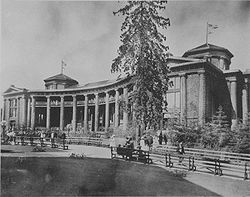

Olmsted Brothers
The Olmsted Brothers company was an influential landscape design firm in the United States, formed in 1898 by stepbrothers John Charles Olmsted and Frederick Law Olmsted, Jr. .-History:...
of Brookline, Massachusetts, were selected to plan the Exposition; the firm was already involved in planning parks and parkways for the City of Seattle. John C. Olmsted visited Seattle in October 1906 and saw the dominant form of Mount Rainier
Mount Rainier
Mount Rainier is a massive stratovolcano located southeast of Seattle in the state of Washington, United States. It is the most topographically prominent mountain in the contiguous United States and the Cascade Volcanic Arc, with a summit elevation of . Mt. Rainier is considered one of the most...
toward the southeast. He selected the mountain as the focus of the primary axis of the Exposition. This axis later became the Rainier Vista of the University of Washington campus.
The principal landscape architect for the fair was the Olmsted firm's James Frederick Dawson
James Frederick Dawson
James Frederick Dawson was an American landscape architect. His father, Jackson Thornton Dawson, was superintendent of the Arnold Arboretum, and Dawson himself was actually born in the arboretum. Dawson graduated from Harvard University in 1896 and joined the Olmsted Brothers landscape design...
. His design centered on a long pool with a series of short waterfalls along Rainier Vista. John Galen Howard's
John Galen Howard
John Galen Howard was an American architect.He is best known for his work as the supervising architect of the Master Plan for the University of California, Berkeley campus, and for founding the University of California's architecture program...
firm, Howard and Galloway, based in San Francisco, was chosen as supervising architects for the Exposition buildings. They designed several buildings and supervised construction of those designed by other architects.
The fairgrounds were entirely ready for the June 1, 1909 opening.
Exhibits
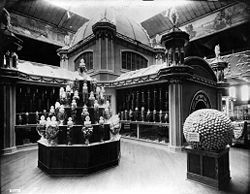
Japan
Japan is an island nation in East Asia. Located in the Pacific Ocean, it lies to the east of the Sea of Japan, China, North Korea, South Korea and Russia, stretching from the Sea of Okhotsk in the north to the East China Sea and Taiwan in the south...
and Canada, but their presence was enough to validate the "Pacific" theme along with the US territory of Hawaii
Hawaii
Hawaii is the newest of the 50 U.S. states , and is the only U.S. state made up entirely of islands. It is the northernmost island group in Polynesia, occupying most of an archipelago in the central Pacific Ocean, southwest of the continental United States, southeast of Japan, and northeast of...
and the Philippines
Philippines
The Philippines , officially known as the Republic of the Philippines , is a country in Southeast Asia in the western Pacific Ocean. To its north across the Luzon Strait lies Taiwan. West across the South China Sea sits Vietnam...
, recently ceded to the US by Spain. Other foreign countries were represented on a smaller scale. The very popular King County exhibit included a scale model of the coal mine at nearby Newcastle, Washington
Newcastle, Washington
Newcastle is an Eastside city in King County, Washington, United States. Its population was 10,380 at the 2010 census.Although Newcastle was not incorporated until 1994, it has been an important settlement and town since the late 19th century and played a major role in the development of Seattle...
and dioramas of several Seattle scenes, the originals of which were only a trolley ride away. The Woman's Building emphasized the role of women in pioneering the American West and in current charity work. The Pay Streak was Seattle's answer to Chicago's Midway
Midway Plaisance
The Midway Plaisance, also known locally as the Midway, is a park on the South Side of the city of Chicago, Illinois. It is one mile long by 220 yards wide and extends along 59th and 60th streets, joining Washington Park at its east end and Jackson Park at its west end. It divides the Hyde Park...
and featured games of chance and amusements. There was also a reenactment of the American Civil War
American Civil War
The American Civil War was a civil war fought in the United States of America. In response to the election of Abraham Lincoln as President of the United States, 11 southern slave states declared their secession from the United States and formed the Confederate States of America ; the other 25...
naval Battle of Hampton Roads
Battle of Hampton Roads
The Battle of Hampton Roads, often referred to as either the Battle of the Monitor and Merrimack or the Battle of Ironclads, was the most noted and arguably most important naval battle of the American Civil War from the standpoint of the development of navies...
(the Battle of Monitor
USS Monitor
USS Monitor was the first ironclad warship commissioned by the United States Navy during the American Civil War. She is most famous for her participation in the Battle of Hampton Roads on March 9, 1862, the first-ever battle fought between two ironclads...
and Merrimack
USS Merrimack (1855)
USS Merrimack was a frigate and sailing vessel of the United States Navy, best known as the hull upon which the ironclad warship, CSS Virginia was constructed during the American Civil War...
)
Attendance
Opening Day, June 1, was declared a city holiday, and 80,000 people attended. Attendance was even higher—117,013—on "Seattle Day". Other big draws were days dedicated to various ethnic groups, fraternal organizations, and U.S. states. By the time the fair closed on October 16, over 3,700,000 had visited.Legacies
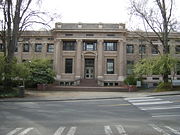
Although most of the Exposition's buildings were designed as temporary structures, intended to last only for the duration of the fair, some were more permanent. The Fine Arts Palace was designed by Howard and Galloway as a chemistry building. It was used during the A-Y-P for the exhibit of art. After the Exposition was over, chemistry lab tables and other furnishings were moved in and it became the University's primary facility for teaching chemistry. The building was named "Bagley Hall" (after Daniel Bagley) and retained that name until 1937, when a new chemistry building named "Bagley Hall" opened. The older building then became the home of Architecture and Physiology. The building survives today, albeit with extensive renovation and restoration, and is known as Architecture Hall.
The A-Y-P Women's Building also survives. During the fair it housed exhibits related to women. Today the building is named Cunningham Hall (after Imogen Cunningham
Imogen Cunningham
Imogen Cunningham was an American photographer known for her photography of botanicals, nudes and industry.-Life and career:...
), one of only a few buildings on the University of Washington campus named for women. During the Exposition itself the building was clad in stucco; today it is faced in wood siding. The building now houses various educational and other programs related to women.

Husky Union Building
Husky Union Building is a building at the University of Washington. It was opened in October 1949, and transferred from the Associated Students of the University of Washington to the university administration in April 1962.- External links :...
(HUB). The original Meany Hall, the AYP Auditorium Hall, was damaged by an earthquake in 1965 and subsequently demolished. Another example is the Hoo-Hoo-House, designed by architect Ellsworth Storey, a clubhouse with reception spaces constructed for the Hoo-Hoos
Concatenated Order of Hoo-Hoo
The International Concatenated Order of Hoo-Hoo, Incorporated is a fraternal and service organization whose members are involved in the forests products industry. Hoo-Hoo has members in the United States, Canada, Australia, New Zealand, Malaysia and South Africa...
, a lumbermen's fraternity. After the fair, this building served as the faculty club until it was replaced in 1958-60 by the current faculty club.
Another legacy of the fair was the enhanced status of exposition president J. E. Chilberg. Although a respected banker, Chilberg had never really been one of the city's elite. He was drafted into his position with the fair simply as a man who was known to be good at getting things done, but without consideration by the city's elite that they had just made an outsider into something tantamount to royalty for the duration of a social season. Suddenly, any party at their First Hill
First Hill, Seattle, Washington
First Hill is a neighborhood in Seattle, Washington, named for the hill on which it is located. The hill, in turn, is so named for being the first hill one encounters traveling east from downtown Seattle toward Lake Washington....
home became a major event in the social calendar. He and his wife found themselves dining with a close relative of the emperor of Japan
Emperor of Japan
The Emperor of Japan is, according to the 1947 Constitution of Japan, "the symbol of the state and of the unity of the people." He is a ceremonial figurehead under a form of constitutional monarchy and is head of the Japanese Imperial Family with functions as head of state. He is also the highest...
and hosting a French
France
The French Republic , The French Republic , The French Republic , (commonly known as France , is a unitary semi-presidential republic in Western Europe with several overseas territories and islands located on other continents and in the Indian, Pacific, and Atlantic oceans. Metropolitan France...
ambassador.
A statue of William H. Seward
William H. Seward
William Henry Seward, Sr. was the 12th Governor of New York, United States Senator and the United States Secretary of State under Abraham Lincoln and Andrew Johnson...
, originally erected for the fair, now stands in Volunteer Park (Seattle)
Volunteer Park (Seattle)
Volunteer Park is a 48.3 acre park in the Capitol Hill neighborhood of Seattle, USA.-History:Volunteer Park was acquired by the city of Seattle for $2,000 in 1876 from J.M. Colman...
.
William Boeing
William Boeing
William Edward Boeing was an American aviation pioneer who founded The Boeing Company.-Biography:Boeing was born to a wealthy German mining engineer named Wilhelm Böing who had made a fortune and who had a sideline as a timber merchant...
, founder of Boeing
Boeing
The Boeing Company is an American multinational aerospace and defense corporation, founded in 1916 by William E. Boeing in Seattle, Washington. Boeing has expanded over the years, merging with McDonnell Douglas in 1997. Boeing Corporate headquarters has been in Chicago, Illinois since 2001...
, stated that it was during the Alaska-Yukon-Pacific Exposition when he saw a manned flying machine for the first time and became fascinated with aircraft.
Human Exhibits
A month old orphaned boy named Ernest was raffled away as a prize. Although a winning ticket was drawn, nobody claimed the prize. The ultimate destiny of the child is still being investigated.Other human exhibits included displays presenting Igorot
Igorot
Cordillerans are the people of the Cordillera region, in the Philippines island of Luzon. The word, Igorot is a misnomer term invented by the Spaniards in mockery against the Nortnern Luzon tribes. The word ‘Igorot’ also as coined and applied by the Spaniards means a savage, head-hunting and...
people from the Philippines as dog-eating, primitive people, the "Alaskan Siberians — Eskimos" and a Chinese village depicting opium dens and recounting the recent Boxer Rebellion
Boxer Rebellion
The Boxer Rebellion, also called the Boxer Uprising by some historians or the Righteous Harmony Society Movement in northern China, was a proto-nationalist movement by the "Righteous Harmony Society" , or "Righteous Fists of Harmony" or "Society of Righteous and Harmonious Fists" , in China between...
.
Premature babies were also displayed in French physician Alexandre Lion's incubators, decades before such systems were commonplace in hospitals. This display was not unique to the Alaska–Yukon–Pacific Exposition; babies had been displayed in incubators since the 1896 Berlin Exposition. Given the robustness of the infants seen in photographs, there is some question as to whether these infants actually required extra care or if they were simply used for profit. Particular to this exhibit was a Baby Incubator Cafe which is seen in some photos, although historians are unsure if this was an actual cafe or rather a place to view babies feeding. At the time there was little in the way of protest from either fair-goers or physicians. In fact there was already a seasonal incubator exhibit at Luna Park in West Seattle, the Infant Electrobator concession. The babies were mentioned by name in the newspaper during their stay at the exposition and their medical state followed throughout. A specific point of interest was the range in ethnicity of the infants. No deaths were experienced amongst the babies at the exhibit.
Anniversary
The year 2009 was the centennial of the Alaska–Yukon–Pacific Exposition. The City and University held various activities to celebrate this anniversary.A documentary was produced by John Forsen called "AYP-Seattle's Forgotten World's Fair" for PBS, available online.
On July 4, 2009 a group of 12 cyclists set off from Santa Rosa, California
Santa Rosa, California
Santa Rosa is the county seat of Sonoma County, California, United States. The 2010 census reported a population of 167,815. Santa Rosa is the largest city in California's Wine Country and fifth largest city in the San Francisco Bay Area, after San Jose, San Francisco, Oakland, and Fremont and 26th...
on a 1,000 mile bike ride to Seattle, Washington to support the disease Histiocytosis
Histiocytosis
In medicine, histiocytosis refers to an excessive number of histiocytes, , and is typically used to refer to a group of rare diseases which share this as a characteristic...
. The ride, titled Wheels North, was a centennial of the 1909 adventure of Vic McDaniel and Ray Francisco who traveled on bicycles to the Exposition. The ride ended at the Drumheller Fountain, in the center of Frosh Pond on the campus of the University of Washington on July 16, 2009. Drumheller Fountain is one of the last known remnants from the 1909 fair.
External links
- "A-Y-P Exposition Community" Alaska–Yukon–Pacific Exposition Centennial for Washington State, 1909–2009
- University of Washington Libraries Digital Collections – Alaska-Yukon-Pacific Exposition Photographs 660 photographs of buildings, grounds, entertainment and exotic attractions.
- Glimpses of the Alaska-Yukon-Pacific exposition (1909); Digitized page images & text from the Library of Congress. — published for the exposition.
- AYPE.com; An evolving, non-commercial project of image display and text.
- Alaska, Land of the Midnight Sun (Sheet Music written for the AYP) interactive hypermedia at the BinAural Collaborative Hypertext
- us1909.com; A comprehensive exhibition of postage stamps issued in 1909, including the Scott 370 & 371, Alaska-Seward issue.

